The Gypsum-free Plaster Market is estimated to be valued at USD 2.9 billion in 2025 and is projected to reach USD 4.1 billion by 2035, registering a compound annual growth rate (CAGR) of 3.4% over the forecast period.
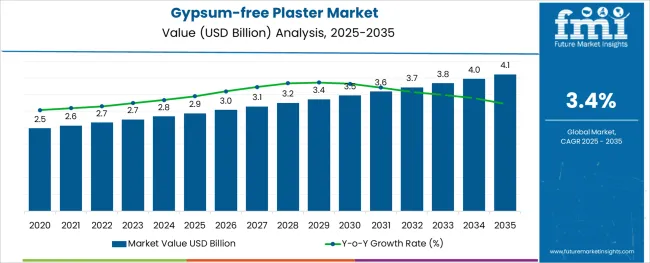
The gypsum-free plaster market is witnessing steady growth driven by the demand for durable and quick-setting construction materials. Industry insights have highlighted increasing preferences for plaster products that offer enhanced strength and reduced setting times, supporting faster project completion. Growing construction activities in residential and commercial segments are accelerating the use of advanced plaster formulations.
Innovations in cement chemistry have enabled the development of gypsum-free plasters that avoid some drawbacks of traditional gypsum-based products, such as moisture sensitivity. Regulatory push toward sustainable and fire-resistant building materials is also influencing market dynamics.
Expansion in infrastructure and renovation projects further boosts demand, especially in regions with humid climates where gypsum-free plasters offer advantages. The market outlook remains promising as manufacturers continue to refine products for improved performance and ease of application. Segmental growth is expected to be led by Modified Quick Binding High Strength Cement in the type segment and Ordinary Portland cement applications, which continue to dominate usage due to their proven reliability and versatility.
The market is segmented by Type and Application and region. By Type, the market is divided into Modified Quick Binding High Strength Cement, Quick Binding Cement Lute, Gypsum Free Quick Binding High Strength Cement, and Quick Setting High Strength Cement. In terms of Application, the market is classified into Ordinary Portland, White, Aluminous, and Others. Regionally, the market is classified into North America, Latin America, Western Europe, Eastern Europe, Balkan & Baltic Countries, Russia & Belarus, Central Asia, East Asia, South Asia & Pacific, and the Middle East & Africa.
The market is segmented by Type and Application and region. By Type, the market is divided into Modified Quick Binding High Strength Cement, Quick Binding Cement Lute, Gypsum Free Quick Binding High Strength Cement, and Quick Setting High Strength Cement. In terms of Application, the market is classified into Ordinary Portland, White, Aluminous, and Others. Regionally, the market is classified into North America, Latin America, Western Europe, Eastern Europe, Balkan & Baltic Countries, Russia & Belarus, Central Asia, East Asia, South Asia & Pacific, and the Middle East & Africa.
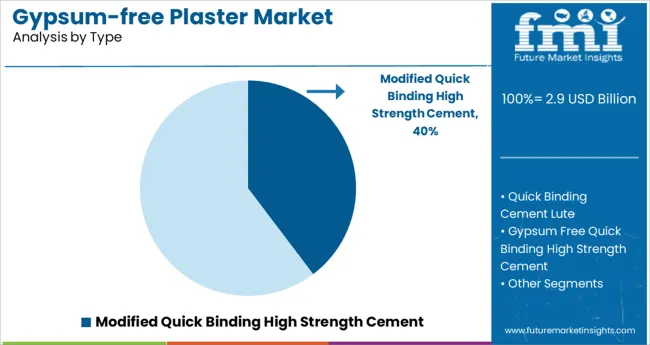
The Modified Quick Binding High Strength Cement segment is anticipated to hold 39.7% of the gypsum-free plaster market revenue in 2025. Growth in this segment has been driven by the demand for plasters that set rapidly while providing superior mechanical strength. Construction professionals have favored these modified formulations to reduce project timelines and improve durability.
Their enhanced binding properties allow for better adhesion and crack resistance, making them suitable for a variety of structural and finishing applications. The segment benefits from continuous product innovations that address workability and environmental performance.
As builders seek materials that combine speed and strength without compromising quality, this type segment is expected to sustain robust demand.
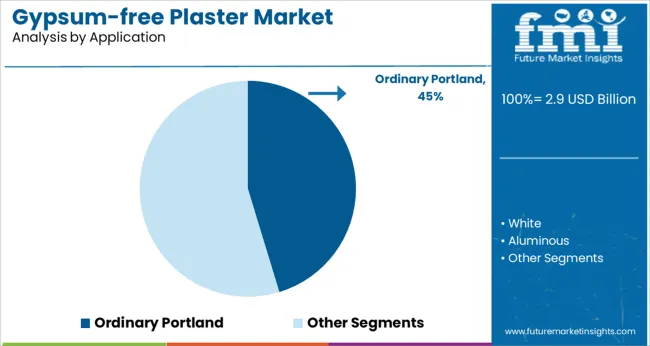
The Ordinary Portland cement segment is projected to contribute 45.3% of the gypsum-free plaster market revenue in 2025, maintaining its dominance in applications. Its widespread acceptance is owed to its availability, cost-effectiveness, and well-understood performance characteristics.
This segment has benefited from extensive use in both new construction and repair work where consistent strength and durability are required. Ordinary Portland cement-based plasters offer good compatibility with various substrates and are adaptable to diverse climatic conditions.
Increasing infrastructure and housing developments continue to fuel demand in this application category. As construction sectors in developing and developed regions expand, Ordinary Portland cement remains a staple choice, supporting steady market growth.
Rising investments in building and construction activities, growing trend of green building, and continuous new product launches are some of the major factors driving growth in the global gypsum-free plaster market.
Similarly, increasing investments in R&D and presence of a stringent regulatory framework are expected to push the demand for gypsum-free plaster during the forecast period.
Gypsum-free plasters have become ideal alternatives to gypsum due to their highly efficient and ecofriendly nature. They are being used by builders and contractors during construction activities. Thus, rapid growth of building and construction industry will eventually create lucrative growth prospects within the global gypsum-free plaster market during the forecast period.
Similarly, growing concerns regarding the negative environmental impact of gypsum due to extensive CO2 emission and high energy consumption during manufacturing is prompting both manufacturers and end users to shift their preference towards gypsum-free plasters. This will bode well for market growth.
Leading companies like Tarmac are continuously launching new innovative gypsum-free plaster ranges to cater to the rising demands. Gypsum-free products like Limelite, launched by Tarmac are gaining wider popularity due to their ability to combat frequent challenges of damp, mold, and trapped moisture.
Although gypsum-free plaster is gradually becoming popular, there are certain factors that are limiting the growth of gypsum-free plaster market. Some of these factors include increasing usage of gypsum for numerous applications and low availability of gypsum-free plaster across various developing and underdeveloped regions.
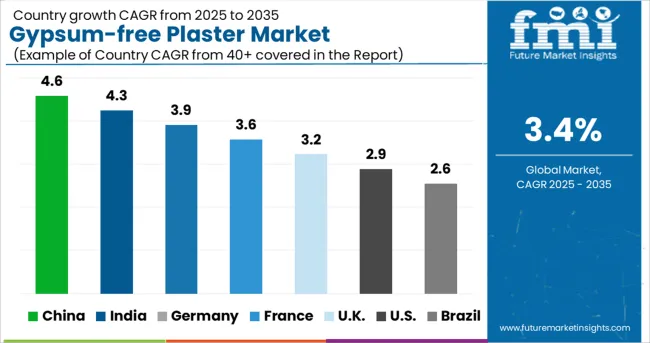
As per FMI, Asia Pacific gypsum-free plaster market is expected to grow at a relatively higher CAGR during the forecast period, owing to the rapidly expanding building and construction industry, favorable government support, growing focusing green building, and increase in the number of gypsum-free plaster manufacturers.
Over the years, there has been robust expansion of construction sector across fast growing countries like China and India due to economic growth, increasing government initiatives and investments, and a strong focus on modernization. This rise in construction industry is creating space for gypsum-free plaster market growth in the region.
Similarly, rising awareness among people about the benefits of using gypsum-free plaster over gypsum will further create opportunities for gypsum-free plaster manufacturers in Asia pacific.
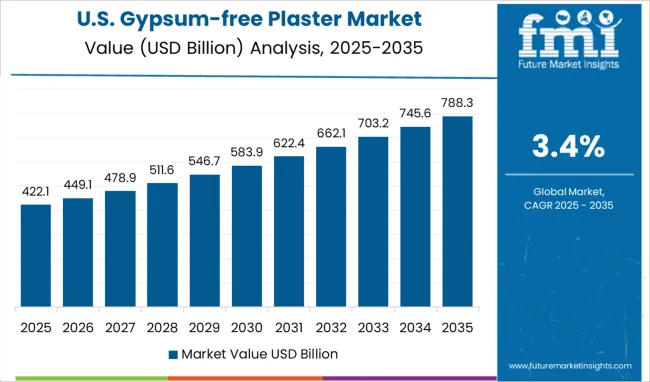
Factors such as rapid expansion of building and construction industry, increasing government investments in developing public infrastructure, and changing consumer preference towards using gypsum-free plaster are pushing demand for gypsum-free plaster across the North America.
Gypsum-free plaster markets of Canada, Mexico, and the USA are witnessing substantial growth due to increasing spending on construction and increasing trend of green building.
According to the United States Census Bureau, construction spending in the USA totaled around USD 1,744,801 million in April 2025. This in turn is creating a conducive environment for gypsum-free plaster market growth in the region.
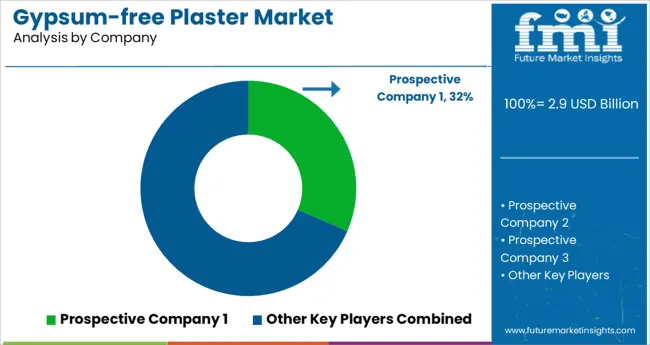
Some of the leading gypsum-free plaster manufacturers include Tarmac, Knauf AG, Global Mining company, Yoshino Gypsum Co. Ltd., Jonoub Gypsum, Saint Gobain, American Gypsum, Georgia Pacific, Zawami Minerals Co., and Gypsona among others.
These key players are constantly focusing on introducing novel gypsum-free plaster solutions with efficient features. Besides this, they are adopting various organic and inorganic strategies such as mergers, acquisitions, collaborations etc. to expand their global footprint.
| Report Attribute | Details |
|---|---|
| Growth Rate | CAGR of 3.4% from 2025 to 2035 |
| Projected Market Size (2035) | ~USD 4 billion |
| Base Year for Estimation | 2024 |
| Historical Data | 2020 to 2024 |
| Forecast Period | 2025 to 2035 |
| Quantitative Units | Revenue in billion and CAGR from 2025 to 2035 |
| Report Coverage | Revenue Forecast, Volume Forecast, Company Ranking, Competitive Landscape, Growth Factors, Trends and Pricing Analysis |
| Segments Covered | Type, Application, Region
|
| Regions Covered |
North America; Latin America; Western Europe; Eastern Europe; APEJ; Japan; Middle East and Africa |
| Key Countries Profiled | USA, Canada, Brazil, Argentina, Germany, UK, France, Spain, Italy, Nordics, BENELUX, Australia & New Zealand, China, India, ASEAN, GCC, South Africa
|
| Key Companies Profiled | Tarmac; Knauf AG; Jonoub Gypsum; Yoshino Gypsum Co. Ltd.; Georgia Pacific; Global Mining company; American Gypsum; Saint Gobain; Zawami Minerals Co.; Rajasthan State Mines; AI Jood Natural Resources; Vinayak Gypsum; Arcosa Specialty Chemicals; Gypsona; Boero USA
|
| Customization | Available Upon Request |
The global gypsum-free plaster market is estimated to be valued at USD 2.9 billion in 2025.
It is projected to reach USD 4.1 billion by 2035.
The market is expected to grow at a 3.4% CAGR between 2025 and 2035.
The key product types are modified quick binding high strength cement, quick binding cement lute, gypsum free quick binding high strength cement and quick setting high strength cement.
ordinary portland segment is expected to dominate with a 45.3% industry share in 2025.






Our Research Products

The "Full Research Suite" delivers actionable market intel, deep dives on markets or technologies, so clients act faster, cut risk, and unlock growth.

The Leaderboard benchmarks and ranks top vendors, classifying them as Established Leaders, Leading Challengers, or Disruptors & Challengers.

Locates where complements amplify value and substitutes erode it, forecasting net impact by horizon

We deliver granular, decision-grade intel: market sizing, 5-year forecasts, pricing, adoption, usage, revenue, and operational KPIs—plus competitor tracking, regulation, and value chains—across 60 countries broadly.

Spot the shifts before they hit your P&L. We track inflection points, adoption curves, pricing moves, and ecosystem plays to show where demand is heading, why it is changing, and what to do next across high-growth markets and disruptive tech

Real-time reads of user behavior. We track shifting priorities, perceptions of today’s and next-gen services, and provider experience, then pace how fast tech moves from trial to adoption, blending buyer, consumer, and channel inputs with social signals (#WhySwitch, #UX).

Partner with our analyst team to build a custom report designed around your business priorities. From analysing market trends to assessing competitors or crafting bespoke datasets, we tailor insights to your needs.
Supplier Intelligence
Discovery & Profiling
Capacity & Footprint
Performance & Risk
Compliance & Governance
Commercial Readiness
Who Supplies Whom
Scorecards & Shortlists
Playbooks & Docs
Category Intelligence
Definition & Scope
Demand & Use Cases
Cost Drivers
Market Structure
Supply Chain Map
Trade & Policy
Operating Norms
Deliverables
Buyer Intelligence
Account Basics
Spend & Scope
Procurement Model
Vendor Requirements
Terms & Policies
Entry Strategy
Pain Points & Triggers
Outputs
Pricing Analysis
Benchmarks
Trends
Should-Cost
Indexation
Landed Cost
Commercial Terms
Deliverables
Brand Analysis
Positioning & Value Prop
Share & Presence
Customer Evidence
Go-to-Market
Digital & Reputation
Compliance & Trust
KPIs & Gaps
Outputs
Full Research Suite comprises of:
Market outlook & trends analysis
Interviews & case studies
Strategic recommendations
Vendor profiles & capabilities analysis
5-year forecasts
8 regions and 60+ country-level data splits
Market segment data splits
12 months of continuous data updates
DELIVERED AS:
PDF EXCEL ONLINE
Plaster Accelerator Market Analysis - Size, Share, and Forecast Outlook 2025 to 2035
Dental Plaster Market Trends – Growth, Demand & Forecast 2024-2034
Earthen Plasters Market Size and Share Forecast Outlook 2025 to 2035

Thank you!
You will receive an email from our Business Development Manager. Please be sure to check your SPAM/JUNK folder too.
Chat With
MaRIA